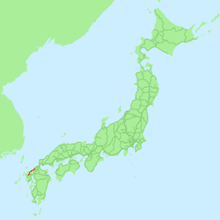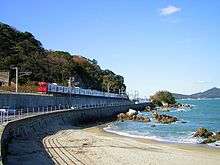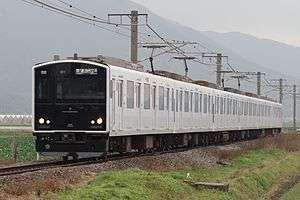Chikuhi Line
The Chikuhi Line (筑肥線, Chikuhi-sen) is a railway line in Kyushu, Japan, connecting Meinohama Station in Fukuoka, Fukuoka (and via a subway through service, Fukuoka itself) to Karatsu Station in Karatsu, Saga, and from Yamamoto Station in Karatsu to Imari Station in Imari, Saga. Trains from Karatsu to Imari use the Karatsu Line to Yamamoto.[1][2]
| Chikuhi Line | |
|---|---|
| Overview | |
| Native name | 筑肥線 |
| Type | Commuter rail |
| System | JR Kyushu |
| Locale | Fukuoka, Saga |
| Stations | 29 |
| Operation | |
| Opened | 5 December 1923 |
| Operator(s) | JR Kyushu |
| Technical | |
| Line length | 42.6 km (26.5 mi) (Meinohama–Karatsu) 25.7 km (16.0 mi) (Yamamoto–Inari) |
| Track gauge | 1,067 mm (3 ft 6 in) |
| Electrification | 1,500 V DC overhead (Meinohama–Nishi-Karatsu) |
| Operating speed | 85 km/h (53 mph) |


Route data
- Operators and distances
- JR Kyushu
- From Meinohama to Karatsu: 42.6 km (26.5 mi)
- From Yamamoto to Imari: 25.7 km (16.0 mi)
- JR Kyushu
- Track gauge: 1,067 mm (3 ft 6 in)
- Stations: 29
- Double-track: From Meinohama to Chikuzen-Maebaru
- Electrified track: Meinohama to Nishi-Karatsu only; Yamamoto to Imari is unelectrified
Stations
Meinohama to Karatsu/Nishi-Karatsu
- ●: Stops, |: Does not stop
- Rapid Service: Stops at every station on the Kūkō Line
| No. | Station | Japanese | Distance (km) |
Rapid service stops | Transfers | Location | |||
|---|---|---|---|---|---|---|---|---|---|
| Weekdays | Weekends | ||||||||
| Chikuhi Line | |||||||||
| Continues to Fukuokakūkō Station on the Kūkō Line | |||||||||
| JK 01 | Meinohama | 姪浜 | 0.0 | ● | ● | Fukuoka City Subway: Kūkō Line (through service) | Nishi-ku, Fukuoka | Fukuoka | |
| JK 02 | Shimoyamato | 下山門 | 1.6 | ● | | | ||||
| JK 03 | Imajuku | 今宿 | 5.2 | ● | | | ||||
| JK 04 | Kyūdai-Gakkentoshi | 九大学研都市 | 6.8 | ● | ● | ||||
| JK 05 | Susenji | 周船寺 | 8.1 | ● | | | ||||
| JK 06 | Hatae | 波多江 | 10.1 | ● | | | Itoshima | |||
| JK 07 | Itoshima-Kokomae | 糸島高校前 | 11.4 | ● | ● | ||||
| JK 08 | Chikuzen-Maebaru | 筑前前原 | 12.7 | ● | ● | ||||
| JK 09 | Misakigaoka | 美咲が丘 | 14.3 | | | | | ||||
| JK 10 | Kafuri | 加布里 | 15.4 | | | | | ||||
| JK 11 | Ikisan | 一貴山 | 16.7 | | | | | ||||
| JK 12 | Chikuzen-Fukae | 筑前深江 | 20.1 | ● | ● | ||||
| JK 13 | Dainyū | 大入 | 23.3 | | | | | ||||
| JK 14 | Fukuyoshi | 福吉 | 26.1 | | | | | ||||
| JK 15 | Shikaka | 鹿家 | 30.2 | | | | | ||||
| JK 16 | Hamasaki | 浜崎 | 35.4 | ● | ● | Karatsu | Saga | ||
| JK 17 | Nijinomatsubara | 虹ノ松原 | 37.5 | | | | | ||||
| JK 18 | Higashi-Karatsu | 東唐津 | 39.3 | ● | ● | ||||
| JK 19 | Watada | 和多田 | 40.9 | ● | ● | ||||
| JK 20 | Karatsu | 唐津 | 42.6 | ● | ● | Karatsu Line (to Yamamoto/Saga) | |||
| Karatsu Line | |||||||||
| JK 21 | Nishi-Karatsu | 西唐津 | 44.8 | ● | ● | ||||
Yamamoto to Imari
| Station | Japanese | Distance (km) |
Connecting lines | Location | |
|---|---|---|---|---|---|
| Yamamoto | 山本 | 0.0 | Karatsu Line | Karatsu | Saga |
| Hizen-Kubo | 肥前久保 | 5.1 | |||
| Nishi-Ōchi | 西相知 | 6.6 | |||
| Sari | 佐里 | 8.2 | |||
| Komanaki | 駒鳴 | 11.0 | Imari | ||
| Ōkawano | 大川野 | 12.9 | |||
| Hizen-Nagano | 肥前長野 | 14.3 | |||
| Momonokawa | 桃川 | 17.4 | |||
| Kanaishihara | 金石原 | 19.7 | |||
| Kami-Imari | 上伊万里 | 24.1 | |||
| Imari | 伊万里 | 25.7 | Matsuura Railway: Nishi-Kyūshū Line | ||
Rolling stock
- 103-1500 series six-car EMUs[3]
- 303 series six-car EMUs (since 22 January 2000)[3]
- 305 series six-car EMUs (since February 2015)
A fleet of six new 305 series six-car electric multiple unit (EMU) commuter trains was introduced on the Chikuhi Line from February 2015.[4]
 103-1500 series set E17 in August 2008
103-1500 series set E17 in August 2008 303 series set K02 in November 2009
303 series set K02 in November 2009 A 305 series set on the Chikuhi Line in January 2016
A 305 series set on the Chikuhi Line in January 2016
History
The Kita-Kyushu Railway opened the Fukuyoshi to Hamasaki section in 1923, extending it west to Higashi-Karatsu (situated on the east bank of the Matsuura River, opposite the Karatsu Line on the west bank) by 1925 and east to Hakata by 1926. The line was again extended west to Yamamoto where it junctioned with the Karatsu line (establishing Higashi-Karatsu as a reversing station in the process) in 1929, and to Imari in 1935. The company was nationalised in 1937 after which Japanese Government Railways (JGR) designated the track as the Chikuhi Line.[5]
In 1983, the Hakata to Meinohama section was closed and replaced by a link to the Fukuoka City Subway Airport Line. A new line from Nijinomatsubara to Karatsu opened (including a new station called Higashi-Karatsu, situated about 1.5 km (0.93 mi) southeast of the original station of that name) and the entire section was electrified at 1,500 V DC to allow through running to Fukuoka via the subway. At the same time, the original Nijinomatsubara to Yamamoto section closed.[5][6][2]
References
- "JR Kyushu Route Map" (PDF). JR Kyushu. Retrieved 3 March 2018.
- JR Kyushu (2013). JR九州のひみつ [Secrets of JR Kyushu] (in Japanese). PHP Institute, Inc. pp. 82–83. ISBN 9784569814933.
- JR電車編成表 2014夏 [JR EMU Formations - Summer 2014]. Japan: Kotsu Shimbunsha. 30 May 2014. pp. 220–221. ISBN 978-4-330-46614-9.
- JR九州 筑肥線に305系通勤型直流電車投入 [JR Kyushu to introduce 305 series DC commuter trains on Chikuhi Line]. Tetsudo Hobidas (in Japanese). Japan: Neko Publishing. 1 August 2014. Retrieved 1 August 2014.
- Ishino, Tetsu; et al., eds. (1998). 停車場変遷大事典 国鉄・JR編 [Station Transition Directory - JNR/JR] (in Japanese). I. Tokyo: JTB Corporation. pp. 224–5. ISBN 4533029809.
- Imao, Keisuke (2009). 日本鉄道旅行地図帳 12号 九州 沖縄―全線・全駅・全廃線 [Japan Rail Travel Atlas No. 12 Kyushu Okinawa - all lines, all stations and disused lines] (in Japanese). Mook. pp. 22, 41–2. ISBN 9784107900302.
.svg.png)